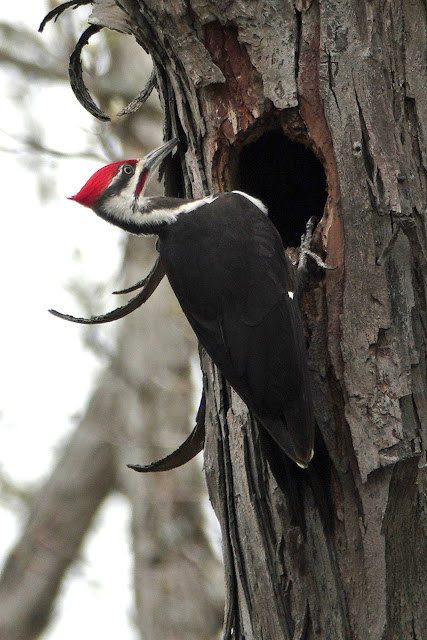The latest is a special surprise, the pileated woodpecker.
 |
| Somme photographer Lisa Culp Musgrave photographed this recently-returned, nesting pileated woodpecker at Deer Grove. |
 |
| For your amusement, I photographed the Somme pileated. With my cell phone! Can you see it? On the base of that downed log? |
| Okay, here's the blow up of my cell photo. Not the best? But sure enough, there is a pileated woodpecker in Somme! |
Normally, this spectacular crow-sized woodpecker is found in very large, old, open woods. Before last evening, we’d never seen one at Somme.
Chicagoland Birds by Ellen Thorne Smith (Field Museum 1958, revised 1972) categorized the pileated as “not normally found in the Chicago region.” For recorded occurrences, she shows three dots in spring and six in fall, but not a single dot during the breeding season. But it's not a total surprise these days. The pileated now breeds regularly in the big Palos forest preserves and has returned to Deer Grove.
For me, this big bird was just part of a delicious adventure. I’d been scything invasive cat-tails from one of the Somme ponds, standing knee deep in clean cool water that increasingly, with our efforts, has fewer and fewer narrow-leaved cat-tail and more and more sweet flag, bur reed, blue-flag iris, yellow floating buttercup, and more. My work with the scythe was surgical, slow, methodical, zen. Animals relaxed. A sora rail called. A green heron appeared. Birds, frogs, and salamanders seem to prefer this "more restored" pond to the nearby, larger, less-restored one.
Suddenly behind me I heard a loud and strange squawk. What? I know most of the Somme squawks. But this was not a Cooper’s hawk, not a green heron, nor a baby owl. I turned, and my jaw dropped. There was one of the few pileated woodpeckers I’d ever seen.
It was clearly talking to me. Why was I there, so close a log it had been working on? It had probably watched me for some time and ruled me likely harmless. When it called, and I turned and looked, I stayed chill, as it appeared to the pileated, and it flew toward me, landed on that downed log, and started chopping out large chunks of soft wood.
 |
| Pileated woodpeckers eat mostly ants. Lisa's photo caught its tongue sticking into a hole the bird drilled for ants. The sticky tongue fishes them out. |
 |
| The rarest bird that has come back to Somme is the red-headed woodpecker. Once common, their global numbers have been plummeting. Four pair nested in Somme's open woods last summer. They often show off near the end of the parking lot. |
 |
| Woodcocks are also high on the conservation concern list. These two chicks survived a three-inch snowfall - only to be startled by us as we pulled garlic mustard. The woodhen tried to lure us away. We followed her, to be polite, but first photographed these cuties. |
 |
| One last Lisa photo. The green heron eats Somme's large insects, frogs, and salamanders - not too many, we hope. But good habitat provides more for all. |
Since this post was first published in 2019, at least two pileated woodpeckers have become regulars in Somme Woods. They often have quite a bit to say to us when we pass through some of their favorite areas. We've seen them fussing over nest holes, but we haven't seen young ones yet.
The volunteer restoration heroes who work at Somme,
season after season, year after year after year,
are making it a greater and greater place.
Acknowledgements
Thanks to Lisa Culp Musgrave for the good bird photos.


2 comments:
Appreciate this blog posst
Fabulous!
Post a Comment